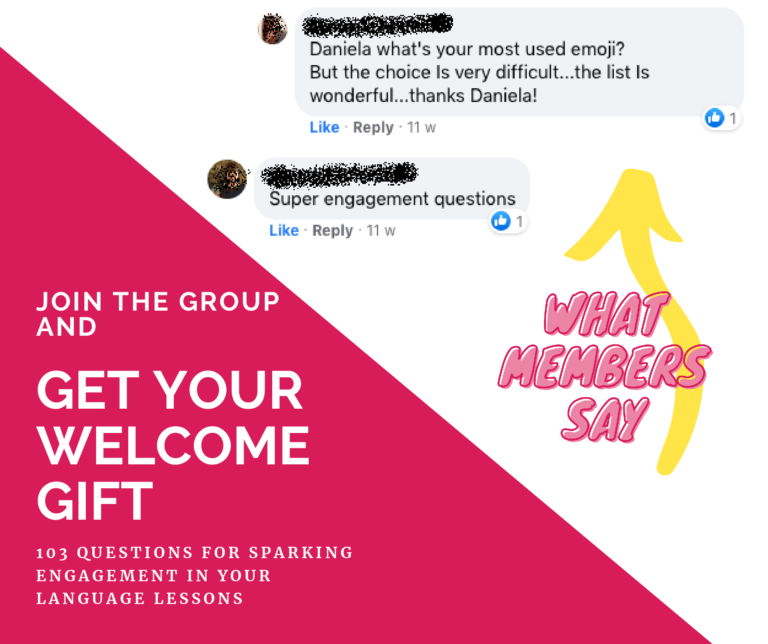
Not sure about how to give feedback in your language lessons to boost engagement and to get your students to speak?
In this article I’m going to answer that question and to show you how the suggestopedic principle of Love becomes a very practical approach when it comes to language teaching, rather than a theoretical concept, as many teachers might think.
No fine accomplishments have been made in this world without love. G. Lozanov
Love is one of the seven laws of Suggestopedia. It is a fundamental principle and the first one among the seven suggestopedic principles. It means genuine love for the human being, humanistic love. According to Suggestopedia, Love is ‘an essential condition for accessing the reserves of mind’ (Georgi Lozanov, 2009). Love creates serenity, trust and contributes to the prestige of the teacher in the eyes of the students and thus opens the ways of tapping the reserves in the personality’s paraconsciousness.’ (Georgi Lozanov, 2009).
Like parents teaching their child to ride a bicycle
Dr. Lozanov explained the suggestopedic principle of Love by means of the metaphor of ‘a mother or father teaching their children how to ride a bicycle without the child being able to tell at each moment whether the parent is holding the bicycle from behind or not.’ (Georgi Lozanov, 2009). In other words, the teacher accompany the students through unobtrusive guidance and takes constantly care of their acquisition process without them to be aware of their teacher’s support.
What does it mean caring about our language students?
There are a number of ways we, as language teachers, can show love to our students and help them to make the most of their potential skills. Setting up a welcoming learning environment, planning the lessons, proposing games and fun activities for getting the students engaged, inviting the students to take part in the exercises, all these are examples for caring.
In another article of this blog ‘The top easy-to-implement strategies for getting your students to speak and engaged’ you can find more insights and lots of ideas about this, all condensed into five strategies you can start to implement right away. There is one strategy, though, that I left behind because it is so important that it deserves a dedicated article. I’m talking about giving feedback.
Get the FREE GUIDE ‘How to give feedback in your language lessons – without knocking down your students’ self-confidence!’:
Feedback is the climax within a language lesson that boosts engagement
Feedback is the climax within a language lesson. In fact, feedback has an impact on at least three levels:
- On the acquisition level – this is the level of the students’ skills development (how they did and what they can do in order to do better)
- On the relationship level – the level where the bond students-teacher is set (how students trust and respect the teacher as a coach and a mentor)
- On the identity level – how students judge themselves depending on how they did in a lesson.
Personally, I will never understand the reason why so many teachers don’t give enough importance and time to this very sensitive phase of the lesson. Giving feedback should be the king in language lessons. On the contrary, many teachers see the moment of giving feedback as something to get done as quickly as possible before jumping to the next exercise. Some other teachers see it even as a waste of time.
Whatever the reason, the truth is that feedback can leave signs in our language students. If we are able to give good feedback, we are helping our students to grow and to become aware of their acquisition process. If we give bad feedback, we are only mining their self-esteem and we are getting them stuck in the grey area of learned incompetence.
What is good feedback and what is bad feedback?
Good and bad refer to the method of giving feedback, rather than referring to the content of the feedback. Under this point of view, by good I mean effective. In other words, you can give good feedback on tons of ‘mistakes’ and improvement areas, as well as you can give bad feedback on strengths only.
What is good, effective feedback that boosts engagement?
Good, effective feedback enables our students to:
- To become aware of their strengths
- To get clear on the next step they need to take in order to improve their skills
- To feel motivated and positive about their acquisition process.
On the contrary, bad feedback doesn’t help the students to get clear neither on their strengths and improvement areas, nor on the actions they should take to progress. In this scenario, usually students get only a number of improvement areas to work on.
The good news is that good feedback has specific features and, by following a method, we can always be able to deliver effective feedback.
What does good feedback look like?
Effective feedback has got four essential features:
- It has a precise structure, it’s called ‘sandwich feedback’, which helps you to point out the students’ improvement areas without overwhelming the students by tons of goals they otherwise would be supposed to work towards.
- It comes from the observation of behaviours: feedback is factual. This makes feedback far easier to be given, explained, commented by you on one hand and received by your students on the other hand.
- It always refers to the specific moment when the observations took place, so that your observations will hardly become judgemental labels on your students.
- It has got dedicated time within a lesson. Feedback shouldn’t interrupt the students during an exercise (e.g. while they are speaking).
The FREE guide ‘How to give feedback without knocking down your students’ self confidence!’ explains everything you need to know about giving effective feedback so that you get your students to speak and engaged. Also, it provides you with all the essential insights and two super-good tools for you to be able to implement some good practice right away. Get ready to learn all you need to know about how to give feedback in language lessons to boost engagement!
Get the FREE GUIDE ‘How to give feedback in your language lessons – without knocking down your students’ self-confidence!’:
I invite you to delve into the free guide, put it into use and… why not: let me know how you are getting on with all the tips the guide provided you with!
Enjoy your free guides. Let’s spark Love!
Want more support?
Join the Facebook group Independent Language Teachers Collective to get daily advice, tons of free training and to branch out with other independent language teachers like you!
ALSO…
Available only for the Collective members: free list 103 question for sparking engagement in your language lessons.
This is what members say about the freebie:

Join in the Collective and grab your welcome gift:
Join Facebook Group

